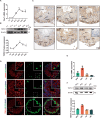The involvement of TRPV1 in the apoptosis of spermatogenic cells in the testis of mice with cryptorchidism
- PMID: 40180900
- PMCID: PMC11968804
- DOI: 10.1038/s41420-025-02447-3
The involvement of TRPV1 in the apoptosis of spermatogenic cells in the testis of mice with cryptorchidism
Abstract
Cryptorchidism is associated with an increased risk of male infertility and testicular cancer. Persistent exposure to high temperature in cryptorchidism can lead to the apoptosis of spermatogenic cells. Transient receptor potential vanilloid 1 (TRPV1), a thermosensitive cation channel, has been found to have differential effects on various apoptosis processes. However, whether TRPV1 is involved in spermatogenic cell apoptosis induced by cryptorchidism remains unclear. Herein, we first observed the expression pattern of TRPV1 in the testes of mice with experimental cryptorchidism, and then investigated the role and mechanism of TRPV1 in spermatogenic cell apoptosis by using Trpv1-/- mice. The results showed that TRPV1 was highly expressed on the membrane of spermatocytes in mouse testis, and the expression increased significantly in the testis of mice with experimental cryptorchidism. After the operation, Trpv1-/- mice exhibited less reproductive damage and fewer spermatogenic cell apoptosis compared to the wild-type (WT) mice. Transcriptome sequencing revealed that the expression of apoptosis-related genes (Capn1, Capn2, Bax, Aifm1, Caspase 3, Map3k5, Itpr1 and Fas) was down-regulated in spermatocytes of cryptorchid Trpv1-/- mice. Our results suggest that TRPV1 promotes the apoptosis of spermatocytes in cryptorchid mice by regulating the expression of apoptosis-related genes.
© 2025. The Author(s).
Conflict of interest statement
Competing interests: The authors declare no competing interests. Ethics approval and consent to participate: All methods in this study were performed in accordance with the relevant guidelines and regulations. All animal care and experimental procedures were conducted according to the guidelines approved by the Institutional Animal Care and Use Committee of Air Force Military Medical University (IACUC-20220159).
Figures






Similar articles
-
[Expression of Dnajb13 and its involvement in the apoptosis of spermatogenic cells in the testis of the mouse with cryptorchidism].Zhonghua Nan Ke Xue. 2020 Mar;26(3):228-236. Zhonghua Nan Ke Xue. 2020. PMID: 33346962 Chinese.
-
Overexpression of endothelial nitric oxide synthase in transgenic mice accelerates testicular germ cell apoptosis induced by experimental cryptorchidism.J Androl. 2005 Mar-Apr;26(2):281-8. doi: 10.1002/j.1939-4640.2005.tb01096.x. J Androl. 2005. PMID: 15713835
-
Expression pattern of testis-specific expressed gene 2 in cryptorchidism model and its role in apoptosis of spermatogenic cells.J Huazhong Univ Sci Technolog Med Sci. 2010 Apr;30(2):193-7. doi: 10.1007/s11596-010-0212-3. Epub 2010 Apr 21. J Huazhong Univ Sci Technolog Med Sci. 2010. PMID: 20407872
-
The fate of germ cells in cryptorchid testis.Front Endocrinol (Lausanne). 2024 Jan 3;14:1305428. doi: 10.3389/fendo.2023.1305428. eCollection 2023. Front Endocrinol (Lausanne). 2024. PMID: 38234428 Free PMC article. Review.
-
Cryptorchidism, gonocyte development, and the risks of germ cell malignancy and infertility: A systematic review.J Pediatr Surg. 2020 Jul;55(7):1201-1210. doi: 10.1016/j.jpedsurg.2019.06.023. Epub 2019 Jul 5. J Pediatr Surg. 2020. PMID: 31327540
References
-
- Aldahhan RA, Stanton PG. Heat stress response of somatic cells in the testis. Mol Cell Endocrinol. 2021;527:111216. - PubMed
-
- Gopalakrishnan NP, Chung IM. Alteration in the expression of antioxidant and detoxification genes in chironomus riparius exposed to zinc oxide nanoparticles. Comp Biochem Physiol B Biochem Mol Biol. 2015;190:1–7. - PubMed
-
- Mieusset R, Bengoudifa B, Bujan L. Effect of posture and clothing on scrotal temperature in fertile men. J Androl. 2007;28:170–5. - PubMed
-
- Palnitkar G, Phillips CL, Hoyos CM, Marren AJ, Bowman MC, Yee BJ. Linking sleep disturbance to idiopathic male infertility. Sleep Med Rev. 2018;42:149–59. - PubMed
Grants and funding
LinkOut - more resources
Full Text Sources
Research Materials
Miscellaneous

